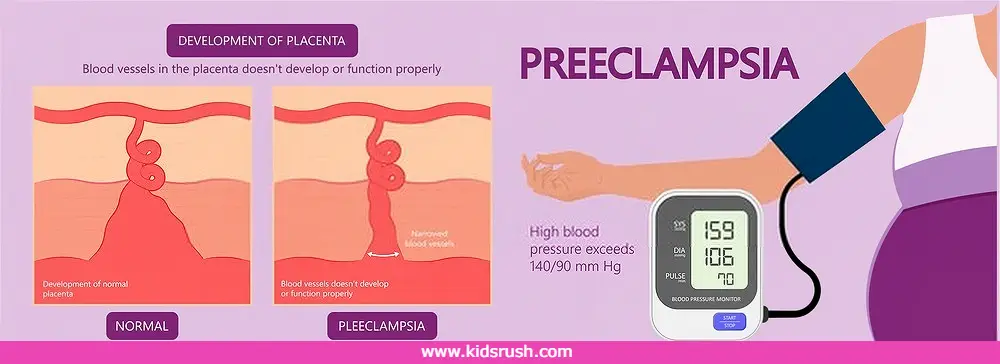The problem of postpartum hypertension can cause headaches, blurred vision, and hypersensitivity to light. We explain how this can happen and discuss whether or not it can be prevented.
It is known as postpartum hypertension when the blood pressure rises above normal after delivering a baby. Other terms for postpartum hypertension would be postpartum preeclampsia and protein in the urine.
Hypertension following the birth of the baby usually develops shortly after, although it can take up to six weeks for some women. Women who have a history of high blood pressure are more likely to suffer from it.
It can cause serious complications, especially in mothers. For this reason, we will explain how to treat postpartum hypertension in this article.
Postpartum hypertension – what is it?

In the puerperium period (thirty-two to sixty days after the baby is born), mothers’ blood pressure rises because their body’s hormones are released.
High blood pressure during pregnancy is a risk for women who already have high blood pressure. SYSTOLIC blood pressure should not exceed 140 millimeters of mercury (mmHg) and diastolic blood pressure should not exceed 90 mmHg.
However, its presence in any mother is not ruled out. That is why pregnant women with pre-eclampsia and eclampsia should be aware of the symptoms and keep them in mind.
Few studies have been conducted that differentiate the incidence of postpartum hypertension as a separate condition. An article in the BMJ states that pregnant women are at a higher risk for high blood pressure.
Both postpartum preeclampsia and hypertension are hypertensive disorders, but in preeclampsia, protein is excreted in the urine at greater amounts than in hypertension.
Read Also: 10 Tips To Regain Figure After Pregnancy
Risks and symptoms
The symptoms of both high blood pressure and postpartum preeclampsia are often nonspecific, making it difficult to diagnose.
‘However, one of the most common signs is headache,’ say Mayo Clinic specialists. Hypertension can appear as early as the first week of a woman’s pregnancy or whenever during the first 40 days.
High blood pressure or elevated blood pressure for a prolonged period can present with other symptoms. Women may experience temporary blindness, blurred vision, or hypersensitivity to light.
Among the common symptoms of postpartum preeclampsia are decreased urination and decreased urine output. Protein levels in the urine can increase, and there may be upper abdominal pain.
Read Also: How to raise low blood pressure in pregnancy
Postpartum hypertension: what causes it?
Postpartum hypertension is not well understood. The causes are unknown. It’s known that blood volume overload occurs during pregnancy. This can cause blood pressure to increase along with the appearance of edema, that is, fluid accumulation in soft tissues.
In the weeks after delivery, all the fluid in the extravascular space is reabsorbed, and therefore the arterial walls are under greater pressure.
Several factors have been identified that may increase the risk of being pregnant with low birth weight: chronic high blood pressure and previous hypertension.
The risk is also increased when blood pressure was high during a past pregnancy or when preeclampsia occurred. Diabetes and obesity have a significant impact on postpartum hypertension as well.
Read Also: 9 Months Pregnant: Symptoms, Development, and Activities
Problems that may arise
It is possible to become eclamptic from postpartum hypertension or preeclampsia. This condition causes severe kidney and brain impairment, seizures, and even death.
Thromboembolism, on the other hand, occurs when a blood clot obstructs a blood vessel. Pulmonary edema also occurs when fluid is excessively accumulated in the lungs.
This is because oxygen-depleted portions of the brain stop receiving blood from the postpartum period. [1]
Postpartum hypertension: diagnosis and treatment
To make sure your blood pressure is under control after delivery, it is essential to be aware of the symptoms of postpartum hypertension.
If a woman’s prior history of preeclampsia has occurred, postpartum medical follow-up is essential. Urinalysis is usually performed on postpartum hypertension to differ from preeclampsia.
Getting rid of high blood pressure is essential, and antihypertensive drugs such as ACEIs or ARBs are often used.
Although they are safe to take during breastfeeding, they should always be prescribed by a doctor.
Women with postpartum preeclampsia who have severe symptoms may be prescribed drugs to prevent seizures. Since magnesium sulfate prevents seizures, it is particularly useful for women with severe postpartum preeclampsia.
Read Also: 16 Home And Medical Remedies To Remove Stretch Marks After Pregnancy
Is it possible to prevent postpartum hypertension?
Some factors predispose to postpartum hypertension, such as family history and age, cannot be changed. However, some may greatly reduce the risk.
Pregnancy is a time when a healthy lifestyle is emphasized. Diet should be an important factor. Eat a varied diet, avoid foods rich in saturated fat or salt.
The maintenance of proper weight and regular moderate exercise is also recommended. Many doctors recommend Yoga during pregnancy. For women at high risk of preeclampsia or hypertension, regular doses of aspirin may be recommended.
A risk disorder
Untreated, postpartum hypertension can lead to serious complications, including strokes. Because it typically goes unnoticed, its incidence is unknown.
The risk for postpartum preeclampsia is also higher since it is often related to postpartum hypertension. It is also a situation that requires longer hospital stays after childbirth. Therefore these women must have good support from family and friends.

